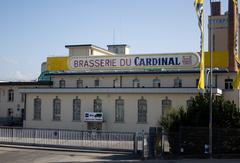
Pont de Pérolles Visiting Guide
Date: 01/08/2024
Introduction
The Pont de Pérolles, located in the enchanting city of Fribourg, Switzerland, is much more than a simple bridge. It stands as a testament to the region’s historical evolution, engineering prowess, and cultural richness. Constructed in the early 20th century, this concrete arch bridge not only revolutionized local infrastructure but also became a symbol of progress and resilience for the people of Fribourg. Spanning the Sarine River, the bridge connects the Pérolles district with the Old Town, facilitating easier access and boosting local commerce. The Pont de Pérolles has witnessed significant milestones in Fribourg’s journey towards modernization, from its industrial boom to the establishment of key industries and transportation networks. Its architectural elegance, coupled with its strategic importance, makes it a must-visit landmark for tourists and a beloved historical monument for locals. This comprehensive guide delves into the bridge’s history, architectural marvels, economic impact, cultural significance, and essential visitor information, offering a holistic view of one of Fribourg’s most iconic landmarks (source, source).
Table of Contents
- Introduction
- Early Development and Construction
- Strategic Importance
- Architectural Features
- Economic Impact
- Cultural Significance
- Visitor Tips
- Accessibility and Visiting Hours
- Preservation Efforts
- FAQ
- Conclusion
Early Development and Construction
The Pont de Pérolles, inaugurated in late 1922, has played a pivotal role in the development of Fribourg, Switzerland. The bridge was a long-awaited solution for those who had to make extensive detours to reach the city from the right bank of the Sarine River, particularly from Bulle or Haute-Singine. The need for a bridge became increasingly urgent towards the end of the 19th century and the beginning of the 20th century, leading to petitions from local communes and multiple requests to the Grand Council. By the end of 1913, the Grand Council had adopted a decree from the Council of State for the construction of the bridge, initially envisioned as part of a railway line connecting Fribourg, Marly, and Bulle (source).
Strategic Importance
The strategic importance of the Pont de Pérolles cannot be overstated. It significantly shortened travel times and facilitated easier access to the city, thereby boosting local commerce and connectivity. The bridge was constructed during a period when Fribourg was undergoing substantial industrialization, and its completion marked a significant milestone in the city’s infrastructure development. The bridge’s construction was part of a broader effort to modernize the city’s transportation network, which included the development of the railway station quarter and the opening of the A12 highway (source).
Architectural Features
The Pont de Pérolles is an engineering marvel of its time. Built to accommodate both vehicular and pedestrian traffic, the bridge features robust construction designed to withstand the test of time. Its design reflects the architectural trends of the early 20th century, combining functionality with aesthetic appeal. The bridge’s structure includes multiple arches, providing both strength and an elegant visual profile. The use of local materials in its construction not only ensured durability but also helped the bridge blend seamlessly with the surrounding landscape (source).
Economic Impact
The economic impact of the Pont de Pérolles on Fribourg has been substantial. By improving access to the city, the bridge facilitated the movement of goods and people, thereby boosting local businesses and industries. The bridge’s construction coincided with the establishment of several key industries in the region, including a wagon factory, a lumber mill, and later, two breweries. The improved connectivity also played a crucial role in the development of the industrial area on the plateau south and west of the city, which became a hub of economic activity in the 20th century (source).
Cultural Significance
Beyond its economic and strategic importance, the Pont de Pérolles holds significant cultural value for the people of Fribourg. The bridge has been a witness to the city’s transformation over the past century, serving as a symbol of progress and resilience. It has also been a focal point for community events and celebrations, including its centenary celebration in November 2022, which was marked by an official ceremony attended by local dignitaries and residents (source).
Visitor Tips
For tourists visiting Fribourg, the Pont de Pérolles is a must-see landmark. The bridge offers stunning views of the Sarine River and the surrounding landscape, making it an ideal spot for photography enthusiasts. Visitors can also enjoy a leisurely walk across the bridge, taking in the architectural details and the scenic beauty of the area. The bridge’s proximity to other major attractions, such as St. Nicholas Cathedral and the Museum of Art and History, makes it a convenient stop for those exploring the city (source).
Accessibility and Visiting Hours
The Pont de Pérolles is easily accessible from various parts of Fribourg. Visitors can reach the bridge by foot if they are exploring the downtown area or by using public transportation, with several bus routes stopping nearby. For those driving, there are parking facilities available in the vicinity. The bridge is open to the public at all times, and there is no entry fee, making it an accessible and budget-friendly attraction for all visitors (source).
Preservation Efforts
Maintaining the structural integrity and historical significance of the Pont de Pérolles has been a priority for local authorities. Regular maintenance and restoration works have been carried out over the years to ensure that the bridge remains in good condition. These efforts have been crucial in preserving the bridge’s original features while adapting it to meet modern safety standards. The centenary celebration in 2022 also highlighted the community’s commitment to preserving this iconic landmark for future generations (source).
FAQ
- What are the visiting hours for Pont de Pérolles? The bridge is open to the public 24/7.
- Is there an entry fee for Pont de Pérolles? No, there is no entry fee.
- How to get to Pont de Pérolles? The bridge is accessible by foot, public transportation, and car, with nearby parking facilities.
Conclusion
The Pont de Pérolles stands as a testament to Fribourg’s rich history and its ongoing journey towards modernization. Its construction marked a significant milestone in the city’s development, and its continued relevance today underscores its importance as both a functional infrastructure piece and a cultural symbol. For visitors to Fribourg, the bridge offers a unique glimpse into the city’s past while providing a scenic and accessible route for exploring its many attractions.
For more travel tips and updates, follow us on social media or check out our other related posts.
References
- 100 ans du pont de Pérolles, 2022, DIME source
- The Pont de Pérolles, n.d., Fribourg Tourisme source
- Fribourg, n.d., Wikipedia source
- Fribourg, August 2018, Our Swiss Experience source
- Fribourg, August 2018, Ollie Chinny source
- Fribourg, n.d., Wondrous Drifter source
- Fribourg, n.d., Travalour source
- Fribourg, n.d., Trek Zone source





